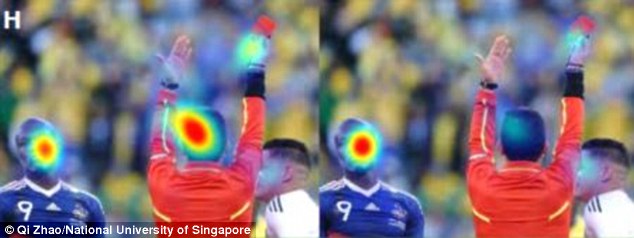AGXStarseed
Well-Known Member
(Not written by me)
How people with autism see the world: Gaze of those with the condition bypasses faces to see details such as colour and contrast
People with autism often describe the world as a confusing mass of faces, places and events.
Scientists say this can partly explain their difficulty socialising and communicating, as well as their restricted interests and repetitive behaviour.
But understanding the exact relationship between the perception and behaviour has, so far, proven difficult.
Now researchers say they have made a breakthrough in this area that could eventually help doctors better diagnose and treat various forms of the disorder.
Scroll down for video

People with autism spectrum disorder (ASD) see the world differently. In this image, the left side is the attention pattern of a person with ASD, the right represents a control subject. The study found people with autism were strongly attracted to the centre of images, regardless of the content placed there
The study looked at how the world is interpreted in the brain of someone with autism spectrum disorder (ASD).
In particular, it tested long-standing assumptions about the condition, including the belief that those with autism often miss facial cues.
'Among other findings, our work shows that the story is not as simple as saying 'people with ASD don't look normally at faces.' They don't look at most things in a typical way,' says Ralph Adolphs, a biology professor at Caltech.
The researchers showed 700 images to 39 subjects. Twenty of the subjects were high-functioning individuals with autism, and 19 were control, or 'neurotypical,' subjects without autism.
The two groups were matched for age, race, gender, educational level, and IQ.
Each subject viewed each image for three seconds while an eye-tracking device recorded their attention patterns on objects depicted in the images.
Unlike the abstract images of single objects or faces that have been used in previous studies, the images that Adolphs and his team presented contained combinations of more than 5,500 objects.

The study backed up previous research by showing that people with autism are less drawn to faces than control subjects. The left shows how an autistic person attends an image of a moment of action. To the right, differing points of attention of a person without autism
These included people, trees, and furniture as well as less common items like knives and flames. They were shown in natural settings, mimicking the scenes that a person see every day.
The study backed up previous research by showing that people with autism are less drawn to faces than control subjects.
It also found these subjects were strongly attracted to the centre of images, regardless of the content placed there.
Similarly, they tended to focus their gaze on objects that stood out - for example, due to differences in colour and contrast - rather than on faces.
For example, one image from the study showing two people talking with one facing the camera and the other facing away so that only the back of their head is visible.
Control subjects concentrated on the visible face, whereas those with autism attended equally to the face and the back of the other person's head.
'The study is probably most useful for informing diagnosis,' Adolphs says.
'Autism is many things. Our study is one initial step in trying to discover what kinds of different autisms there actually are.
'The next step is to see if all people with ASD show the kind of pattern we found.
'There are probably differences between individual people with ASD, and those differences could relate to differences in diagnosis, for instance, revealing subtypes of autism.'
SOURCE: http://www.dailymail.co.uk/sciencet...n-bypasses-faces-details-colour-contrast.html
How people with autism see the world: Gaze of those with the condition bypasses faces to see details such as colour and contrast
- Study found people with autism were attracted to center of images
- Researchers confirmed those with disorder are less drawn to faces
- Results could eventually help doctors better diagnose and treat autism
People with autism often describe the world as a confusing mass of faces, places and events.
Scientists say this can partly explain their difficulty socialising and communicating, as well as their restricted interests and repetitive behaviour.
But understanding the exact relationship between the perception and behaviour has, so far, proven difficult.
Now researchers say they have made a breakthrough in this area that could eventually help doctors better diagnose and treat various forms of the disorder.
Scroll down for video

People with autism spectrum disorder (ASD) see the world differently. In this image, the left side is the attention pattern of a person with ASD, the right represents a control subject. The study found people with autism were strongly attracted to the centre of images, regardless of the content placed there
The study looked at how the world is interpreted in the brain of someone with autism spectrum disorder (ASD).
In particular, it tested long-standing assumptions about the condition, including the belief that those with autism often miss facial cues.
'Among other findings, our work shows that the story is not as simple as saying 'people with ASD don't look normally at faces.' They don't look at most things in a typical way,' says Ralph Adolphs, a biology professor at Caltech.
The researchers showed 700 images to 39 subjects. Twenty of the subjects were high-functioning individuals with autism, and 19 were control, or 'neurotypical,' subjects without autism.
The two groups were matched for age, race, gender, educational level, and IQ.
Each subject viewed each image for three seconds while an eye-tracking device recorded their attention patterns on objects depicted in the images.
Unlike the abstract images of single objects or faces that have been used in previous studies, the images that Adolphs and his team presented contained combinations of more than 5,500 objects.

The study backed up previous research by showing that people with autism are less drawn to faces than control subjects. The left shows how an autistic person attends an image of a moment of action. To the right, differing points of attention of a person without autism
These included people, trees, and furniture as well as less common items like knives and flames. They were shown in natural settings, mimicking the scenes that a person see every day.
The study backed up previous research by showing that people with autism are less drawn to faces than control subjects.
It also found these subjects were strongly attracted to the centre of images, regardless of the content placed there.
Similarly, they tended to focus their gaze on objects that stood out - for example, due to differences in colour and contrast - rather than on faces.
For example, one image from the study showing two people talking with one facing the camera and the other facing away so that only the back of their head is visible.
Control subjects concentrated on the visible face, whereas those with autism attended equally to the face and the back of the other person's head.
'The study is probably most useful for informing diagnosis,' Adolphs says.
'Autism is many things. Our study is one initial step in trying to discover what kinds of different autisms there actually are.
'The next step is to see if all people with ASD show the kind of pattern we found.
'There are probably differences between individual people with ASD, and those differences could relate to differences in diagnosis, for instance, revealing subtypes of autism.'
SOURCE: http://www.dailymail.co.uk/sciencet...n-bypasses-faces-details-colour-contrast.html